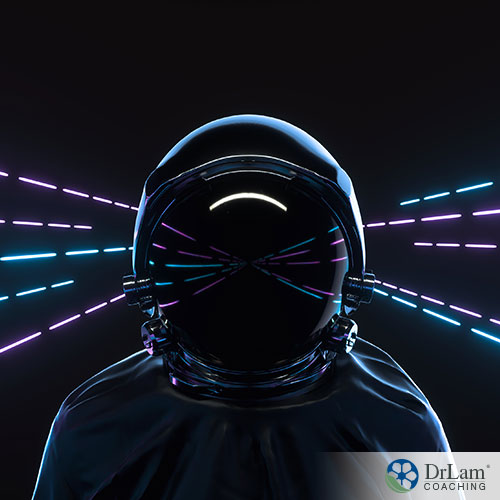Your brain controls most of the systems in your body that maintain life. Therefore, it is important for the brain to function at its highest potential. This particular organ also becomes the target of many acute and chronic conditions. Traumatic events, degenerative conditions, and psychiatric disorders all affect the brain in some way. So researchers spend a great deal of time investigating ways of dealing with these conditions. One new approach, transcranial low-level laser therapy, holds great promise.
 Transcranial low-level laser therapy involves applying highly focused infrared lasers to the brain. The use of infrared light allows the light to penetrate bone and tissue, bringing its energy to the targeted brain areas. It is similar to red light therapy.
Transcranial low-level laser therapy involves applying highly focused infrared lasers to the brain. The use of infrared light allows the light to penetrate bone and tissue, bringing its energy to the targeted brain areas. It is similar to red light therapy.
This type of targeted light causes no pain, no heat, and is non-invasive. It requires no chemicals, and research indicates high safety levels.
The type of light used in transcranial low-level laser therapy can penetrate deep into the tissue of your body because it doesn’t get blocked by your skin. This allows the light to get past your skull to a depth of about four to five cm, well into your brain tissue. A wavelength between 805 nm and 830 nm appears best for this kind of penetration.
Transcranial low-level laser therapy proves useful at a cellular level in the brain as well as other parts of the body. Two main methods of use for this therapeutic approach exist: an infrared LED helmet and an infrared pad. Each method allows for various settings for dealing with different conditions.
This method of use for transcranial low-level laser therapy targets degenerative and traumatic brain conditions. In addition, it is also used for dealing with depression.
Mechanisms of function in dealing with degenerative and traumatic conditions include improving cognition ability, increasing neurogenesis, stimulating more growth of neurons and brain cells, and improving the functioning of mitochondria.
For dealing with depression, the mechanisms of function include increasing mitochondrial oxidative phosphorylation to improve cerebral energy production, increasing the oxygen consumption of the frontal cortex region of the brain, and increasing blood flow velocity in both the left middle cerebral artery and the basilar artery.
In general, use the helmet twice a day for 30 minutes at a time. If you suffer from rashes, start at 40 Hz. If you want to stimulate hair growth, start with 50 Hz and alternate with 727 Hz. And, if you suffer from depression, start with 528 Hz, alternating with 12 Hz. If you want to target an infection such as Lyme, set the helmet at 528 Hz.
In addition, when dealing with Lyme, you can also take cilantro or Boswellia to bind the toxins. Likewise, you can use photosensitizers like Green Tea extract 500mg BID about 30 minutes before the therapy, along with riboflavin and artemisinin on rotating days to increase photobiomodulation of the helmet.
The infrared pad method of low-level laser therapy typically finds use in dealing with soft tissue injuries, joint pain, and fractures. It works by increasing ATP production through stimulation of the last part of the respiratory chain of the mitochondria. This releases cytochrome c oxidase which increases the release of nitric oxide.
In addition, this use enhances natural repair mechanisms and stimulates bone growth. Likewise, it increases the growth of new blood vessels, increases the proliferation of fibroblasts, and increases the activity of macrophages. It also works to reduce inflammation and helps modulate the immune system.
In addition, the use of transcranial low-level laser therapy works to trigger reactive oxygen species (ROS). As a result, the stimulation of mitochondrial signaling pathways takes place to increase anti-oxidant, cytoprotective, and anti-apoptotic effects in cells.
Transcranial low-level laser therapy targets a large number of conditions. Research indicates its usefulness in many of these conditions, and clinical observation supports its use in many more.
 Research shows a combination of 670 nm laser light and epigallocatechin gallate (EGCG) helps to lower the number of amyloid-beta fibrils in human neuroblastoma cells. Amyloid-beta fibrils deposited in the brain forms the basis for the development of Alzheimer’s disease. The EGCG appears to improve the results of laser therapy in reducing the amyloid-beta fibrils.
Research shows a combination of 670 nm laser light and epigallocatechin gallate (EGCG) helps to lower the number of amyloid-beta fibrils in human neuroblastoma cells. Amyloid-beta fibrils deposited in the brain forms the basis for the development of Alzheimer’s disease. The EGCG appears to improve the results of laser therapy in reducing the amyloid-beta fibrils.
The helmet protocol for dealing with Alzheimer’s includes two therapy sessions per week with a gradual increase in time of radiation from 18 to 30 minutes and an increase in energy dose from 2 to 4. Subsequently, within two weeks, the therapies can take place at home. The effects of significantly improved orientation and concentration last for a few hours at this point, requiring continued sessions.
Research indicates the use of transcranial low-level laser therapy proves effective for dealing with the aftermath of ischemic stroke. Two projects found the use of this technique brings significant attenuation of the long-term effects of stroke if applied within 18 hours of the stroke. Further, 810 nm laser light applied over the entire head region provided beneficial results in people with moderate to moderate-severe levels of stroke.
The use of this therapy technique with people suffering from traumatic brain injury in research showed an improvement in mitochondrial function with increased ATP for cellular metabolism. In addition, increased nitric oxide led to increased cerebral blood flow in the region of the injury.
Participants in the research reported better sleep and fewer PTSD symptoms. They and their families reported better occupational, social, and interpersonal functioning.
Research in this area shows near-infrared light is emerging as an effective and safe approach to dealing with this progressive condition. Light therapy in the 600 to 1070 nm range proved capable of stopping neuronal death. And neuronal death is a hallmark of this condition.
The helmet protocol for this condition includes 2-3 therapy sessions per week with a gradual increase in time of radiation from 18 to 30 minutes. Within three weeks, the energy dose is increased from 1 to 4. Following that, the protocol changes to 2-3 therapy sessions per week for 30 minutes at energy dose 4.
The major factors in developing major depressive disorder include neuroinflammation, mitochondrial dysfunction, imbalanced neurotransmitters, and abnormalities in the prefrontal cortex. Between 30 and 40% of those afflicted don’t respond to pharmacotherapy. So, new therapy approaches become the focus of research.
Transcranial low-level laser therapy in 10 Hz pulsed mode appears effective in dealing with the factors listed above. Therefore, it may provide a breakthrough in the management of this condition.
Anytime stress hits your body an automatic mechanism becomes activated. The endpoint of this mechanism lies with your adrenal glands. They release cortisol to fight the effects of stress. But, with chronic stress, the adrenals become fatigued and unable to produce sufficient cortisol. This marks the beginning of AFS. Even though the symptoms of AFS begin sub-clinically, they can progress over time to debilitating levels.
Another mechanism your body uses to fight stress, the NEM consists of six circuits made up of three organs or systems each. These circuits interact in an inter-related manner. This means that what affects one affects others. If stress continues, these circuits can become dysfunctional with serious symptoms resulting.
A significant issue that needs attention concerns how transcranial low-level laser therapy can benefit you if you suffer from AFS. It may help you most if your Neuroaffect circuit of the NEM no longer functions well.
A dysfunctional Neuroaffect circuit affects your brain significantly. Chronic stress stimulates your sympathetic nervous system to release norepinephrine and epinephrine to deal with this stress. And, the result involves a speeding up of your body systems. Because your body produces no hormone to counter epinephrine, the more released means more produced. This leads to panic attacks, anxiety, and a literal burn-out of your body.
 One very significant effect of this dumping of epinephrine into your body concerns its effect on sleep. It produces the "wired and tired" feeling that so many with AFS suffer from.
One very significant effect of this dumping of epinephrine into your body concerns its effect on sleep. It produces the "wired and tired" feeling that so many with AFS suffer from.
Research into transcranial low-level laser therapy shows the procedure helps to slow down your brain waves to a Delta state. In this state, you experience relaxation and sleep. As a result, two things important to those suffering from AFS occur: relaxation, meaning a decrease in stress, and sleep, in which important healing takes place.
In addition, research also shows the use of this technique brings improved concentration, better cognitive abilities, increased memory, improved orientation, and less negative moods. These findings occur in relation to serious illness conditions involving injury or age-related degenerative conditions in the brain.
Chronic stress affects the brain significantly, possibly due to the continual flood of hormones released to fight that stress. The brain centers that regulate emotional response and cognitive function suffer the most from the effects of these hormones. This leads to inaccurate perceptions of what goes on around you and to behaviors that reflect those inaccuracies. Much of the time, depression results.
Research shows transcranial low-level laser therapy may effectively address the issue of major depression.
In the same vein, studies show this technique’s effectiveness in lowering the level of inflammation in your body. Other studies point out the major role played by inflammation in the brain leading to depression. Lowering the level of inflammation generally will likewise lower it in your brain, thus decreasing the risk of depression.
In addition, the ability of this technique to lower overall stress levels can benefit your gut as well. Stress can lead to a condition called ‘leaky gut’ in which pathogens attain access to your bloodstream. When this occurs, your immune system activates to fight the pathogens. With continued numbers of pathogens invading your body in this way, your immune system can become hyperactive, leading it to identify healthy cells as invaders. This leads to the development of autoimmune conditions.
With transcranial low-level laser therapy, overall stress declines. As a result, this allows your gut to heal, re-establishing the balance between healthy and unhealthy bacteria in your microbiome, and preventing conditions like small intestine bacterial overgrowth (SIBO) from developing. SIBO interferes with the digestion and absorption of nutrients, further weakening your already weak body due to AFS. Using this technique to lower stress enables your gut to better digest and absorb nutrients.
This promising technique holds a high potential for addressing a number of conditions that affect your brain. With the dramatic increase in many of these conditions, the effectiveness of such an approach appears exciting.
Although much research remains in the effort to clarify just what the approach can do, it does show beneficial results for many serious conditions, both due to injury and to degenerative causes.
Its ability to decrease stress makes it a valuable alternative for people suffering from AFS. Likewise, its proven ability to address depression can make it very beneficial for many.
If you are suffering from AFS and would like to consider transcranial low-level laser therapy, here are some suggestions.

Whatever course of action you decide to take, however, please do so with the guidance of your healthcare professional who will assess your options and the results they bring.
If you would like to know more about transcranial low-level laser therapy or need assistance with it, the team at Lam Clinic can help. Call us at +1 (714) 709-8000 for a free initial consultation. You can also send us a question through our Ask The Doctor system by clicking here.
Transcranial low-level laser therapy is a method of using targeted light beams to affect the cellular functioning of the brain. These light beams can penetrate the skull and into the tissues of the brain. This method is safe, effective, and non-invasive. Research and clinical experience show no side effects.
